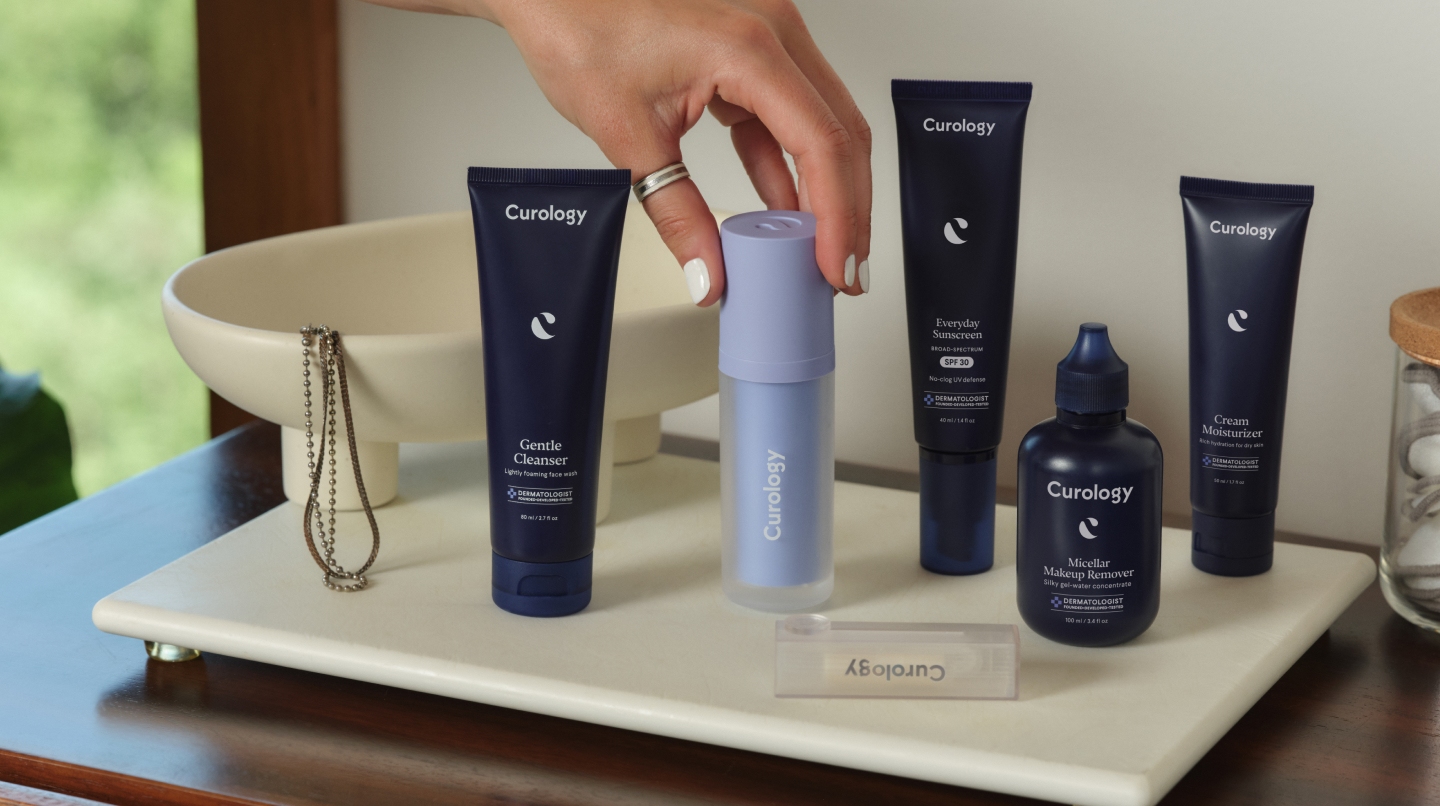How it works:
Share your skin goals and snap selfies
Your dermatology provider prescribes your formula
Apply nightly for happy, healthy skin
How it works:
How it works:
Share your skin goals and snap selfies
Your dermatology provider prescribes your formula
Apply nightly for happy, healthy skin
How it works:
Clindamycin
Clindamycin is a powerful antibiotic that helps stop bacteria growth to prevent the spread of acne.



Pimples, zits, blemishes—nobody likes them, but anybody can get them. Acne happens when dead skin cells and the skin’s natural oil (sebum) mix together and clog pores. Bacteria joins the party, an inflammatory response occurs, and voilà—acne is born. If you have acne, the good news is that there are many ways to treat it. One of those is by eliminating acne-causing bacteria using topical antibiotics like clindamycin.
Here we’ll explain what clindamycin is, its benefits and side effects, and what ingredients work well with it to combat acne.
What is clindamycin?
Clindamycin is a powerful antibiotic that’s particularly good at getting rid of Cutibacterium acnes—acne-causing bacteria that contribute to breakouts and skin inflammation. Generally speaking, there are two main types of acne: non-inflammatory and inflammatory. Non-inflammatory acne manifests as whiteheads and blackheads. Inflammatory acne forms when acne-causing bacteria thrive in the excess sebum and dead skin cells. This creates an inflammatory reaction, which manifests as papules, pustules, nodules, and cysts on the skin’s surface.
Bacteria play a big role in breakouts, and that’s how clindamycin can help.
What does clindamycin treat?
Clindamycin treats acne by penetrating into the pores where bacteria live to curb bacteria’s feeding frenzy and eliminate existing bacteria. Clindamycin is both bacteriostatic and bactericidal, meaning it stops bacteria cells from multiplying and also kills bacteria.
The antibacterial properties of clindamycin prevent protein synthesis. Proteins are necessary for bacteria growth; without them, the production line stops. As a bactericidal, it eliminates bacteria that have already formed.
Clindamycin for acne is used to treat all types of acne, including papules, pustules, and cysts, but it’s available by prescription only.
What are the benefits of clindamycin?
Experts know clindamycin is an effective agent for treating acne. That said, it’s important to remember that everyone’s skin is different, and what works for one person may not work for another. Even so, clindamycin is worth considering as an addition to your skincare regimen to treat acne.
Here are a few benefits of topical clindamycin for acne:
Reduces acne-causing bacteria. Bacteria is one of the contributing factors to acne. Controlling bacteria growth and killing bacteria can reduce breakouts. Clindamycin is proven to be effective at preventing the growth of acne-causing bacteria.
Provides anti-inflammatory effects. Clindamycin acts as an anti-inflammatory to help reduce redness and discomfort associated with breakouts.
Decreases swelling. Clindamycin’s anti-inflammatory properties help reduce swelling associated with acne lesions.
What are the side effects of clindamycin?
Clindamycin comes in a variety of forms including creams, lotions, and gels. For the most part, clindamycin is very well tolerated. However, some people may experience side effects—some of the more common ones are listed below. Talk to your medical or dermatology provider if side effects persist or worsen.
More common effects include:
Dryness or peeling skin
Redness and burning sensation
Itchiness
Oily skin
Other ingredients that work well with clindamycin
Using clindamycin on its own can lead to antibiotic resistance, which is why it’s often paired with other skincare ingredients. Some of the more popular combinations include:
Tretinoin is one of the most popular acne medications available today. A derivative of vitamin A, this potent retinoid accelerates skin cell turnover and boosts collagen production. However, it has its own side effects, which may include redness and irritation.
Benzoyl peroxide is an over-the-counter topical that’s also effective at treating acne. When combined with clindamycin, the two work together to decrease the production of bacteria and purge them from the skin’s surface. Benzoyl peroxide and clindamycin are effective long-term solutions to acne.
Azelaic acid helps reduce C. acnes and improves redness and dark spots. Combined with clindamycin, studies show azelaic acid reduced inflammatory acne lesions after 12 weeks.
Zinc pyrithione is an antimicrobial used to treat dandruff and seborrheic dermatitis, a skin condition with symptoms that include skin flaking, erythema (redness), and pruritus (itching). It effectively treats fungal acne, which often appears along the jaw, forehead, and hairline. The combined use of ZnPT and clindamycin make for a strong acne-fighting treatment.
How to use clindamycin in your skincare routine

Clindamycin is typically prescribed in concentrations of 1% and may be formulated with other active ingredients. At Curology, we combine clindamycin with other actives depending on your unique skin.
But this ingredient is just one part of your skincare routine. A good skincare regime includes cleansing, moisturizing, protecting, and treating. Start by washing your face using a gentle cleanser for your skin type. Rinse with lukewarm water and pat dry with a soft cloth. At night, follow cleansing with your treatment cream containing clindamycin and other active ingredients. Allow the treatment cream to fully absorb before applying a moisturizer for acne-prone skin. If you have dry skin, use a thick moisturizer like Curology’s rich moisturizer. In the morning, skip the treatment cream. Instead, apply a broad-spectrum sunscreen with SPF 30 or higher about 15 minutes before leaving the house.
FAQs
Clindamycin is a powerful antibiotic that’s particularly good at getting rid of Cutibacterium acnes—acne-causing bacteria that contribute to breakouts and skin inflammation. Generally speaking, there are two main types of acne: non-inflammatory and inflammatory.
Clindamycin treats acne by penetrating into the pores where bacteria live to curb bacteria’s feeding frenzy and eliminate existing bacteria.
Here are a few benefits of topical clindamycin for acne:
Reduces acne-causing bacteria. Bacteria is one of the contributing factors to acne. Controlling bacteria growth and killing bacteria can reduce breakouts.
Provides anti-inflammatory effects. Clindamycin acts as an anti-inflammatory to help reduce redness and discomfort associated with breakouts.
Decreases swelling. Clindamycin’s anti-inflammatory properties help reduce swelling associated with acne lesions.
P.S. We did the homework so you don’t have to:
Zaenglein, A. L., et al. Guidelines of care for the management of acne vulgaris. Journal of the American Academy of Dermatology, (2016).
Toyoda, M., Morohashi, M. Pathogenesis of acne. Medical Electron Microscopy. (March 2001).
Murphy, P.B., et al. Clindamycin. StatPearls. (2022 June 17).
James Q. Del Rosso, DO; Nicholas F. Schmidt, PhD. A Review of the Anti-inflammatory Properties of Clindamycin in the Treatment of Acne Vulgaris. Drug Therapy Topics. (January 2010).
Murphy, P.B., et al. Clindamycin. StatPearls. Ibid.
Zasada, M. and Budzisz, E. Retinoids: Active molecules influencing skin structure formation in cosmetic and dermatological treatments.Advances in Dermatology and Allergology. (August 2019).
Leyden, J. and Levy, S. The development of antibiotic resistance in Propionibacterium acnes.Cutis. (February 2001).
Webster, G. Combination of azelaic acid therapy for ane vulgaris. Journal of the American Academy of Dermatology. (2000 August 1).
Mangion, S.E., et al. Targeted delivery of zinc pryithione to skin epithelia. International Journal of Molecular Sciences. (September 2021).
Kristen Jokela is a certified Family Nurse Practitioner at Curology. She obtained her Master of Science in Nursing at the University of South Florida in Tampa, FL.
* Subject to consultation. Subscription is required. Results may vary.

Curology Team

Kristen Jokela, NP-C
Related Articles
Why am I still breaking out with a good skincare routine? Experts explainIs my hairline receding? The signs and stages, explainedHow to remove makeup without makeup remover wipesThe complete guide to face cleansers for every skin typeDoes dermaplaning cause acne? Experts explainPopular Articles
Ask Curology: Is my cold breaking me out?Slugging: The dermatologist-approved skincare hack going viral on TikTokTretinoin vs retinol: What’s the difference?How to create a self-care routine that actually sticksYour 2023 skincare horoscopeTry prescription skincare
Get routine essentials

Good skin days ahead
- Breakouts
- Redness
- Fine lines
- Dark spots
- Hair thinning